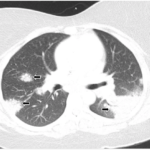“No,” I answered firmly. “Believe me, nothing I can give you is worse than your disease.”
She was unmoved.
Progression

Ruslan Guzov/shutterstock.com
As one month flowed into another, I began to dread the days Mrs. N was on the schedule. Each visit, she would unfold a meticulously detailed graph with the fever curve in red marker and superimposed, in black, the dates Mrs. N suffered night sweats. The intensity of joint and muscle pain—in yellow—varied day to day and week to week, mysteriously shifting from the forearms and calves to the thighs or neck. One day, her joints would be reasonably comfortable, and the next the knuckles would swell to the point she couldn’t make a fist. Increasingly, she needed her husband’s help with simple tasks: buttoning her clothes, pulling up a zipper, cutting her meat.
One busy afternoon, a new consult cancelled, and an hour opened up in the schedule. I opened up Mrs. N’s office chart, spread it out on my desk and logged onto the hospital’s electronic medical record. Maybe I’d overlooked something. At the top of a clean white sheet of paper, I wrote, “FUO” and drew arrows slanting obliquely to broad subcategories: Malignancy, Infection, Connective Tissue Diseases, Psychiatric and Miscellaneous.
Psychiatric? Although elderly, white-haired women are not immune to serious psychopathology (see Arsenic and Old Lace), I’d seen several of Mrs. N’s spells, and there was nothing to suggest fakery. On the other hand … my mind drifted back to a case of psychogenic fever of unknown origin in a woman one of my partners recently consulted on who was admitted with fevers and crops of pustular lesions on the forearms. Despite aggressive antibiotics, the fevers persisted, and new lesions erupted. The consulting service wanted to know, could she have lupus?
After cultures of the mysterious boils were sterile, after surgery incised and drained several of the most dramatic lesions, after dermatology biopsied a lesion and only non-specific inflammatory changes were seen by pathology, a simple explanation ensued. A food service worker bumped the patient’s purse off the edge of the bed, spilling half a dozen filthy needles onto the floor. The patient had been surreptitiously injecting herself with who knows what, for who knows why. Case closed.
Under the heading Malignancy, I reviewed Mrs. N’s workup to date, noting that the Lahey Clinic had picked up a PET (Positron Emission Tomography) scan on their own fishing expedition. This was an important negative, and combined with the CT scans and MRIs at Maine Medical Center, seemed to exclude malignancy as a consideration.


